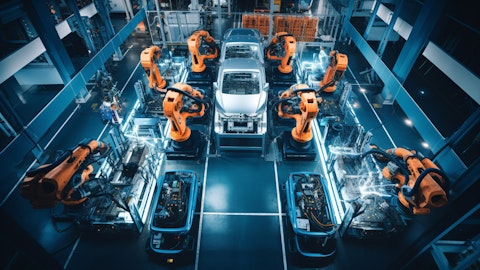Andrew Dete: Yes. No, it certainly is possible. And Brazil is certainly a different grid though, right? So in many parts of the year in Brazil, you’ve got a lot of hydro and a lot of renewable power at very low cost. So there is a merchant opportunity there but it’s going to be more in times of stress where the cost of generating power at these plants is in the money. And we think that certainly is an opportunity but the real big opportunity here is the auctions because they basically allow for a fixed capacity contract and then also the merchant opportunity as well, right? So when you have these capacity contracts, not only are you getting a fixed fee but then you’re also in the sort of regulated and organized market to generate when the system needs you on a JKM basis.
Operator: And we’ll move to our next question that comes from Martin Malloy with Johnson Rice.
Martin Malloy: First question is on Brazil. And outside of the power auctions, could you maybe talk about the outlook for adding additional volumes? I know you mentioned the additional potential volumes for the Norsk Hydro facility. Could you maybe talk about some — how should we — should we be thinking about other opportunities there?
Andrew Dete: Yes. So on the gas supply side, so we’re announcing today our first contract at Santa Catarina which is with the Trans Bolivia pipeline. It’s about a 14 TBtu contract. We’re also working with a number of the other large industrial consumers in the region. We’ve got about 300 TBtu of consumption today on this pipeline system. And our terminal has a few benefits that are kind of outside of just molecule pricing. So first is basically the transport benefit we have. So customers that are buying from us will have a lower basically pipeline fee to pay, than if they’re buying from the other sources which would be either Bolivian gas or offshore gas that comes from the north of Brazil. The second is we can help some of these consumers transition from buying from the regulated distribution companies to buying as what they call the free consumer in Brazil.
They can save some money on that by paying less in regulatory fees. And then also, they can get a contract from us which is much more flexible and is usually designed really around their consumption patterns rather than kind of the inflexible contracts they have today. And then, of course, we can compete on actual price. But there’s a few other benefits as well by kind of going with a more flexible, lower transport cost solution from us. So that’s applicable to a number of the larger kind of industrial consumers who are typically good credits as well in Brazil and we’re working on that. We expect our portfolio in Santa Catarina to look a lot like Barcarena. So if we do this right, we’ll have kind of 1 MTPA of baseload supply which we’ll make money on and will also give us the ability to then go and contract the more intermittent capacity contracts on the power side.
So we might end up with kind of 4 MTPA of sort of total contracted supply, 1 MTPA of which is baseload. And 3 is probably contingent on the power dispatch and linked to international LNG spot prices.
Martin Malloy: Great. Very helpful. And my second question, I just wanted to ask about CapEx. I think it was around $680 million during the first quarter. Could you maybe talk about how that [indiscernible]?
Chris Guinta: Yes. I mean so there’s a lot of — sorry, my mic is not open here guys. There’s a lot of ins and outs because there’s been financing actions and we can — it will be further detailed as you see the notes in the Q. And if you have follow-ups, we can go through it. But fundamentally, when I look at the balance of the rest of the year, there’s very little equity CapEx required to build out what we are executing in Nicaragua and then the conversions in Puerto Rico. Specifically, Marty, it’s about $100 million in total across the terminals and vessels and about $100 million associated with the Puerto Rico expansion. The rest of the CapEx is FLNG 2 in Brazil, both of which are fully financed on a debt base.
Operator: And our next question comes from Chris Robertson with Deutsche Bank.
Chris Robertson: Chris, I just wanted to follow up on that last question just with regards to the CapEx guidance from the previous presentation. I think it was around $1.5 billion. So just trying to see how much of the first quarter CapEx is related to FLNG 1 spending? And then how should we think about the cadence and overall total spend for the remaining part of the year as it relates to gross CapEx?
Chris Guinta: Yes. So I stand by like the $1.5 billion with $1.25 billion being financed, that still kind of works for what we’re expecting in the Brazil assets and FLNG 2. For FLNG 1, we spent in first quarter 2024, around $140 million. And then for the balance of the year, that will really taper off. You’ll still have some spend through April and May, of course, on that asset and then very little spend we expect June, July, August as we kind of complete a few make-ready activities post first LNG. As I mentioned, you spent a little bit of money on the Mexican asset and modest maintenance CapEx in the first quarter for Jamaica and Puerto Rico. And that will obviously be outlined in the Q. And then for the rest of the year, as I said, it’s really not much equity CapEx. It’s really just the terminals and the conversion in Puerto Rico.
Now you will start ramping up CapEx spend for FLNG 2 once you go first LNG on FLNG 1. And then obviously, the Brazil business continues to spend on its build of the Barcarena power plant but all of the CapEx for the terminals should be done as of the end of the first quarter.
Chris Robertson: Right. And just to circle back. So the Barcarena power plant as far as I understand the financing against that is just drawn down in tandem with the spend. So that nets out basically. So there’s no need for equity cash there. But on the second PortoCem facility, is there financing against that one as well? And how much CapEx is going to be spent on the 1.6 gigawatt power project this year?
Andrew Dete: Yes. Yes, perfect. So you’re totally right on the Barcarena power plant. So that’s fully financed with BNDS, the Brazilian Development Bank. And all of the funding is in there and we’ll just draw it down as we keep building. So zero incremental kind of CapEx from the NFE side today or equity CapEx is [indiscernible]. On PortoCem, so same thing basically. So we have closed on a loan with 4 Brazilian banks and we are funding CapEx as we go. We will probably transition that debt structure to a longer-term bond structure in Brazil over the next few months. But from a net result basis for kind of what you’re talking about from a CapEx perspective, same thing, well, we’ll just draw that down over the course of construction from now to then. So we don’t expect really any incremental CapEx from NFE.
Operator: And that concludes today’s question-and-answer session. I’ll turn it now back to Chance Pipitone for any additional and closing remarks.
Chance Pipitone: Great, everyone. Thanks for calling in for the update. Obviously, it’s a clarifying and exciting update from our perspective and I hope that you found it informative. We look forward to following up any questions you have. And we’ll talk to you in a few months. Thank you very much.
Operator: Ladies and gentlemen, this concludes today’s conference. Thank you for your participation. You may now disconnect.
Follow New Fortress Energy Inc. (NASDAQ:NFE)
Follow New Fortress Energy Inc. (NASDAQ:NFE)
Receive real-time insider trading and news alerts




